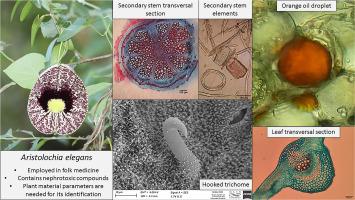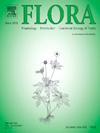Anatomical, histochemical and micrographic analysis of aerial parts of Aristolochia elegans Mast. (Aristolochiaceae), a potentially toxic plant used in folk medicine
IF 1.7
4区 生物学
Q3 ECOLOGY
引用次数: 0
Abstract
Aristolochia elegans (Aristolochiaceae) is a plant species indigenous to South America, widely employed in traditional folk medicine and commonly referred to as 'mil hombres'. Despite its medicinal applications, this plant contains aristolochic acid; a compound associated with the potential risk of chronic intoxications and induced nephropathy following prolonged ingestion. The absence of comprehensive microscopic identification guidelines for A. elegans, whether utilizing fresh, dried, or powdered specimens, highlights the necessity to establish its pharmacognostic diagnostic characteristics ensuring the recognition of the species and its safe and controlled utilization.
Mild dissociations, transversal sections and electron microscopy observations were performed on specimens collected at the Costanera Sur Ecological Reserve and the Buenos Aires Botanical Garden (CABA). In addition, histochemical tests were conducted to asess the presence of primary and secondary metabolites.
The stems exhibited secondary growth, characterized by diffuse porous wood and 7–9 medullary rays. The xylem showed wide scalariform pitted vessel units and fibrotracheids. Whereas the leaves presented hooked trichomes and rodlet-shaped epicuticular wax deposits, a common trait among Aristolochia species. The histochemical analysis revealed the presence of alkaloids in the cortical parenchyma and fibers of the stems and petioles, as well as phenolic compounds in the xylem and cortical parenchyma of young stem and in the lamina mesophyll and abaxial epidermis adjacent to the midrib of the leaf. These micrographic described features serve as valuable tools for identifying A. elegans in commercial samples.

马兜铃科植物马兜铃(Aristolochia elegans Mast.(马兜铃科),一种用于民间医药的潜在有毒植物
马兜铃科植物马兜铃属(Aristolochia elegans)是南美洲土生土长的植物物种,在传统民间医药中被广泛使用,通常被称为 "mil hombres"。尽管马兜铃属植物具有药用价值,但它含有马兜铃酸,这种化合物具有慢性中毒的潜在风险,长期摄入会诱发肾病。无论是利用新鲜标本、干燥标本还是粉末标本,马兜铃科植物都缺乏全面的显微鉴定指南,这突出表明有必要确定其药理诊断特征,以确保识别该物种并安全、有序地使用。此外,还进行了组织化学测试,以评估初级和次级代谢产物的存在情况。茎干表现为二次生长,其特征是弥漫多孔的木质部和 7-9 根髓射线。木质部显示出宽大的鳞片状凹陷血管单元和纤维管。叶片上有钩状毛状体和棒状表皮蜡沉积物,这是马兜铃属植物的共同特征。组织化学分析显示,茎和叶柄的皮层实质和纤维中含有生物碱,幼茎的木质部和皮层实质以及叶中脉附近的叶片中层和背面表皮中含有酚类化合物。这些显微照片描述的特征是在商业样本中鉴别秀丽木的重要工具。
本文章由计算机程序翻译,如有差异,请以英文原文为准。
求助全文
约1分钟内获得全文
求助全文
来源期刊

Flora
生物-植物科学
CiteScore
3.30
自引率
10.50%
发文量
130
审稿时长
54 days
期刊介绍:
FLORA publishes original contributions and review articles on plant structure (morphology and anatomy), plant distribution (incl. phylogeography) and plant functional ecology (ecophysiology, population ecology and population genetics, organismic interactions, community ecology, ecosystem ecology). Manuscripts (both original and review articles) on a single topic can be compiled in Special Issues, for which suggestions are welcome.
FLORA, the scientific botanical journal with the longest uninterrupted publication sequence (since 1818), considers manuscripts in the above areas which appeal a broad scientific and international readership. Manuscripts focused on floristics and vegetation science will only be considered if they exceed the pure descriptive approach and have relevance for interpreting plant morphology, distribution or ecology. Manuscripts whose content is restricted to purely systematic and nomenclature matters, to geobotanical aspects of only local interest, to pure applications in agri-, horti- or silviculture and pharmacology, and experimental studies dealing exclusively with investigations at the cellular and subcellular level will not be accepted. Manuscripts dealing with comparative and evolutionary aspects of morphology, anatomy and development are welcome.
 求助内容:
求助内容: 应助结果提醒方式:
应助结果提醒方式:


